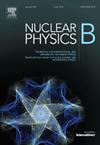Investigating late-time cosmology using Finsler-Randers geometry and Barthel connection: Observational constraints and implications
IF 2.5
3区 物理与天体物理
Q2 PHYSICS, PARTICLES & FIELDS
引用次数: 0
Abstract
In this study we explore cosmological anisotropies and dark energy using Finsler-Randers geometry, an extension of Riemannian geometry that incorporates directional dependence in the spacetime structure. We investigate whether Finslerian modifications including anisotropic corrections can provide a unified theoretical framework to explain both the observed cosmic acceleration and the anisotropies detected in the Cosmic Microwave Background and large-scale structure surveys. By introducing an anisotropic parameter with its parametrization we study its impact on cosmological models and compare the results with observational data from Cosmic Chronometers (CC), Baryon Acoustic Oscillations (BAO), and the Pantheon+ Type Ia Supernovae sample. The constraints on key cosmological parameters including the Hubble constant , matter density parameter , and the anisotropic parameter n, are derived using a Markov Chain Monte Carlo (MCMC) method. Our findings suggest that Finsler-Randers geometry provides a viable alternative to the standard ΛCDM model offering new insights into the nature of DE and large-scale anisotropies. We also examine the consistency of the anisotropic term n across different datasets evaluating its implications for both the evolution of the universe and potential deviations from isotropy. The results highlight the relevance of Finslerian geometry in cosmology and its potential to resolve some of the longstanding puzzles in contemporary cosmology.
用芬斯勒-兰德几何和巴尔特连接研究晚时间宇宙学:观测约束和启示
在这项研究中,我们使用芬斯勒-兰德几何来探索宇宙各向异性和暗能量,芬斯勒-兰德几何是黎曼几何的一种扩展,在时空结构中结合了方向依赖性。我们研究了包括各向异性修正在内的芬斯勒修正是否可以提供一个统一的理论框架来解释观测到的宇宙加速度和宇宙微波背景和大规模结构调查中探测到的各向异性。通过引入各向异性参数η(t)及其参数化,我们研究了其对宇宙学模型的影响,并将结果与Cosmic Chronometers (CC)、重子声学振荡(BAO)和Pantheon+ Ia型超新星样本的观测数据进行了比较。利用马尔可夫链蒙特卡罗(MCMC)方法推导了哈勃常数H0、物质密度参数Ωm和各向异性参数n等关键宇宙学参数的约束。我们的研究结果表明,芬斯勒-兰德几何为标准ΛCDM模型提供了一个可行的替代方案,为DE的性质和大规模各向异性提供了新的见解。我们还研究了各向异性项n在不同数据集上的一致性,评估了其对宇宙演化和对各向同性的潜在偏差的影响。这些结果突出了芬斯勒几何在宇宙学中的相关性,以及它解决当代宇宙学中一些长期存在的难题的潜力。
本文章由计算机程序翻译,如有差异,请以英文原文为准。
求助全文
约1分钟内获得全文
求助全文
来源期刊

Nuclear Physics B
物理-物理:粒子与场物理
CiteScore
5.50
自引率
7.10%
发文量
302
审稿时长
1 months
期刊介绍:
Nuclear Physics B focuses on the domain of high energy physics, quantum field theory, statistical systems, and mathematical physics, and includes four main sections: high energy physics - phenomenology, high energy physics - theory, high energy physics - experiment, and quantum field theory, statistical systems, and mathematical physics. The emphasis is on original research papers (Frontiers Articles or Full Length Articles), but Review Articles are also welcome.
 求助内容:
求助内容: 应助结果提醒方式:
应助结果提醒方式:


